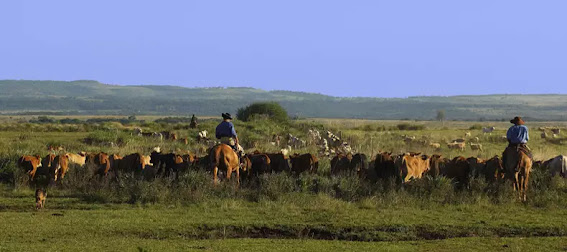 |
| A historic photo of a gaucho (Source: Estancia Ranquilco) |
 |
| Modern day gauchos (Source: Audley Travel) |
ARGENTINIAN-STYLE CHORIPAN
Recipe from Saveur
Serves 4
Ingredients:
- 4 fresh chorizo sausages, Argentinian style if possible
- 4 6-inch hero rolls, split length wise, connected on one side like a hinge
- 1/4 cup finely chopped fresh parsley leaves
- 1/4 cup minced white onion
- 1 clove of garlic, grated using a microplane
- 1/4 cup of extra virgin olive oil, plus 3 tablespoons
- 3 tablespoons red wine vinegar
- 1/2 teaspoon Kosher salt
- 1/4 teaspoon freshly ground black pepper
Directions:
1. Prepare the choripan. Preheat a grill over medium heat. Add the chorizo and let cook, turning occasionally with tongs as needed, until the sides are deeply seared and the center is fully cooked through. 30-35 minutes.
2. Prepare the chimichurri. In a medium bowl, add the parsley, onion and garlic. Stir briefly to combine. Add the olive oil, vinegar, salt and pepper, stirring well. Let rest for at least 15 minutes. (Chimichurri can be left out at room temperature for up to 12 hours before serving.
3. Finish the dish. If desired, briefly warm the insides of the rolls over the grill. You can split the sausages lengthwise if desired as well. Place one cooked sausage into each roll. Slater one side of the roll and some of the sausage generously with chimichurri. Serve immediately.
MAIN COURSE
A cornerstone of Argentine cuisine is asado, or the grilling of meats. The Asador - or cook - prepares the parilla, which is the grill. There are two parts to this grill: one section that houses the charcoal and wood, and another that has the metal grill upon which the meat - known as carne a la parilla - will be cooked. The meat is primarily beef, but lamb, mutton or pork may also find themselves being seared on the grill. As for the cuts or types, one could find chorizo, morcilla (blood sausage), vacio (flank steak), bife ancho (ribeye steak) and lomo (tenderloin).
However, for this culinary challenge, I will assume the role of asador and prepare tira de asado, which are short ribs and which happen to be one of the more popular cuts to grill. The short ribs are not the typical ones that I can find in grocery stores around me. Instead, the Argentinians have their own style, which is a flanken cut across a three or four bone plate. It took a little time, but I was able to find the cut online (as it is the same type of cut used for South Korean kalbi).
One last thing, as with the choripan, this recipe called for the preparation of "traditional chimichurri." The recipe underscores one understanding about chimichurri: there are as many versions of the sauce as there are cooks, gauchos or asadors. This recipe does not use onions, as the chimichurri sauce for the choripan, but it does use crushed red pepper. These changes result in a slightly thinner sauce that has a much stronger kick. That is definitely more to my liking.
TIRA DE ASADO WITH TRADITIONAL CHIMICHURRI
Recipe for the ribs from Food and Wine
Recipe for the chimichurri from Food and Wine
Ingredients (for the short ribs):
- 3.5 pounds of flanken cut, 3 bone beef short ribs
- 1.5 tablespoons coarse sea salt
Ingredients (for the chimichurri):
- 1/4 cup coarsely chopped parsley
- 3 tablespoons red wine vinegar
- 4 large garlic cloves, minced
- 2 tablespoons oregano leaves
- 2 teaspoons crushed red pepper
- Kosher salt
- Freshly ground black pepper
- 1/2 cup extra virgin olive oil
Directions:
1. Prepare the chimichurri. In a food processor, combine the parsley, vinegar, garlic, oregano and crushed red pepper. Process until smooth. Season with salt and pepper. Transfer the sauce to a bowl and pour the olive oil over the mixture. Let stand for 20 minutes.
2. Grill the beef ribs. Preheat the grill (preferably a wood fire) to medium high (400 degrees Fahrenheit to 450 degrees Fahrenheit). Pat the ribs dry with paper towels. Sprinkle all sides of ribs evenly with salt, pressing salt into meat and rubbing it on bones. Arrange the ribs diagonally, spaced 1 inch apart on lightly oiled grates. Grill uncovered and undisturbed until bottoms of ribs are browned and release from grates, about 4 to 6 minutes. Flip ribs, and continue to grill uncovered until browned and a thermometer near the bone but not touching it registers 130 degrees Fahrenheit, about 2 to 4 minutes. Let rest for 5 to 10 minutes.
3. Finish the dish. Serve the ribs whole, or if serving with an assortment of meats for a larger group, cut each rib into thirds on the diagonal. Serve with chimichurri.
* * *
In the end, this challenge satisfied my inner carnivore. Any grilling challenge almost inevitably ends up in the top few of my most favorite challenges. I may not have been out in the middle of nowhere in the Pampas, but from my suburban backyard, I could at least spend a couple of hours as an Asador or a Gaucho. Until next time ...
PEACE.



No comments:
Post a Comment